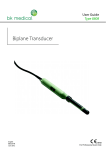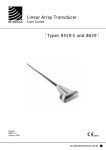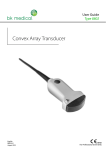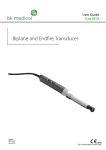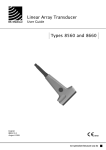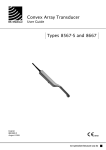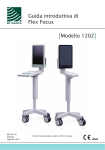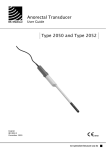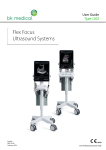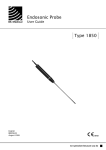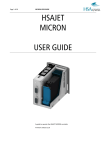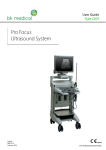Download BK Medical 8824 User guide
Transcript
User Guide Type 8824 I and T Shaped Intraoperative Transducer English BB 1823-C August 2012 For Professional Users Only WORLD HEADQUARTERS Mileparken 34 DK-2730 Herlev Denmark Tel.:+45 44528100 / Fax:+45 44528199 www.bkmed.com Email: [email protected] If you have comments about the user documentation, please write to us at the email address above. We would like to hear from you. BK Medical Customer Satisfaction Input from our customers helps us improve our products and services. As part of our customer satisfaction program, we contact a sample of our customers a few months after they receive their orders. If you receive an email message from us asking for your feedback, we hope you will be willing to answer some questions about your experience buying and using our products. Your opinions are important to us. You are of course always welcome to contact us via your BK Medical representative or by contacting us directly. © 2012 BK Medical Information in this document may be subject to change without notice. Contents Introduction . . . . . . . . . . . . . . . . . . . . . . . . . . . . . . . . . . . . . . . . . . . . . . . . . . . . . . 5 Indications for Use . . . . . . . . . . . . . . . . . . . . . . . . . . . . . . . . . . . . . . . . . . . . . 5 Scanning Planes . . . . . . . . . . . . . . . . . . . . . . . . . . . . . . . . . . . . . . . . . . . . . . . 5 General Information . . . . . . . . . . . . . . . . . . . . . . . . . . . . . . . . . . . . . . . . . . . . . . . 6 Service and Repair . . . . . . . . . . . . . . . . . . . . . . . . . . . . . . . . . . . . . . . . . . . . . 7 Caring for the Transducer. . . . . . . . . . . . . . . . . . . . . . . . . . . . . . . . . . . . . . . . 7 Cleaning and Disinfection . . . . . . . . . . . . . . . . . . . . . . . . . . . . . . . . . . . . . . . . . . . 7 Starting Scanning. . . . . . . . . . . . . . . . . . . . . . . . . . . . . . . . . . . . . . . . . . . . . . . . . . 7 Connecting the Transducer. . . . . . . . . . . . . . . . . . . . . . . . . . . . . . . . . . . . . . . 8 Changing Frequency. . . . . . . . . . . . . . . . . . . . . . . . . . . . . . . . . . . . . . . . . . . . 8 Using a Transducer Cover . . . . . . . . . . . . . . . . . . . . . . . . . . . . . . . . . . . . . . . 8 Changing Orientation . . . . . . . . . . . . . . . . . . . . . . . . . . . . . . . . . . . . . . . . . . . 9 Holding the Transducer for Intraoperative Scanning . . . . . . . . . . . . . . . . . . . . . . 9 Puncture Facilities . . . . . . . . . . . . . . . . . . . . . . . . . . . . . . . . . . . . . . . . . . . . . . . . . 9 Needle guide UA1337 . . . . . . . . . . . . . . . . . . . . . . . . . . . . . . . . . . . . . . . . . 10 Assembling the Needle Guide and Mounting it on the Transducer . . . . . . . 12 Releasing the Needle During Biopsy . . . . . . . . . . . . . . . . . . . . . . . . . . . . . . 13 Performing Puncture and Biopsy. . . . . . . . . . . . . . . . . . . . . . . . . . . . . . . . . . . . . 13 Cleaning after Puncture and Biopsy . . . . . . . . . . . . . . . . . . . . . . . . . . . . . . . 14 Disposal . . . . . . . . . . . . . . . . . . . . . . . . . . . . . . . . . . . . . . . . . . . . . . . . . . . . . . . . 14 3 4 Introduction This is the user guide for I and T Shaped Intraoperative Transducer Type 8824 and must be used together with Care, Cleaning & Safety which contains important safety information. T array I array Figure 1. I and T Shaped Intraoperative Transducer Type 8824 seen from different angles Indications for Use The 8824 is a simultaneous biplane transducer for ultrasound-guided interventional procedures. Needle guide UA1337 provides guidance for needles or other interventional devices during an ultrasound-guided procedure. It positions the needle relative to the transducer, so that the needle image is in a specified position in the ultrasound image during procedures that require precise needle placement or biopsy. WARNING Do not use the transducer for applications where it may come in direct conductive contact with the patient’s heart. FDA WARNING for the United States of America 8824 is not for fetal use. Scanning Planes The transducer contains two convex arrays in the shape of a T. Each array has a single scanning plane and the two scanning planes intersect orthogonally, see Fig. 2 The two scanning planes can be viewed separately or simultaneously, thus giving a better orientation when viewing suspicious lesions. 8824 User Guide (BB1823-C) Introduction 5 Simultaneous Biplane Scanning The transducer can transmit transverse (T) and sagittal (S) images simultaneously. When you press the scanner’s Split button, simultaneous live transmission is automatically activated. On the screen, this is indicated by a green dot in front of the Simultan button. Click on Simultan to toggle simultaneous live transmission on or off. Alternatively, a long press on the scanner’s Split button turns simultaneous live transmission off. When simultaneous transmission is off, you can change which plane is active and which is frozen by pressing the Split button or by placing the cursor on the image you want to be active and pressing the Select button. Transverse plane (T array) Sagittal plane (I array) Figure 2. Scanning planes of the 8824 General Information Product specifications for this transducer can be found in the Product Data sheet that accompanies this user guide. Acoustic output data and data about EMC (electromagnetic compatibility) for this transducer are on the Technical Data CD that accompanies this user guide. A full explanation of acoustic output data is given in your scanner user guide. WARNING If at any time the scanner malfunctions, or the image is severely distorted or degraded, or you suspect in any way that the scanner is not functioning correctly: • Remove all transducers from contact with the patient. • Turn off the scanner. Unplug the scanner from the wall and make sure it cannot be used until it has been checked. • Do not remove the scanner cover. • Contact your BK Medical representative or hospital technician. 6 August 2012 8824 User Guide (BB1823-C) WARNING Always keep the exposure level (the acoustic output level and the exposure time) as low as possible. Service and Repair WARNING Service and repair of BK Medical electromedical equipment must be carried out only by the manufacturer or its authorized representatives. BK Medical reserves the right to disclaim all responsibility, including but not limited to responsibility for the operating safety, reliability and performance of equipment serviced or repaired by other parties. After service or repairs have been carried out, a qualified electrical engineer or hospital technician should verify the safety of all equipment. Caring for the Transducer The transducer may be damaged during use or processing, so it must be checked before use for cracks or irregularities in the surface. It should also be checked thoroughly once a month following the procedure in Care, Cleaning & Safety. Cleaning and Disinfection To ensure the best results when using BK Medical equipment, it is important to maintain a strict cleaning routine. Full details of cleaning and disinfection procedures can be found in Care, Cleaning & Safety that accompanies this user guide. A list of disinfectants and disinfection methods that the transducer can withstand are listed in the Product Data sheet. Sterile covers are available. See the Product Data sheet for more information. WARNING Users of this equipment have an obligation and responsibility to provide the highest degree of infection control possible to patients, co-workers and themselves. To avoid cross contamination, follow all infection control policies for personnel and equipment established for your office, department or hospital. Starting Scanning All equipment must be cleaned and disinfected before use. 8824 User Guide (BB1823-C) Cleaning and Disinfection 7 Connecting the Transducer WARNING Keep all plugs and sockets absolutely dry at all times. The transducer is connected to the scanner using the array Transducer Socket on the scanner. To connect, the transducer plug’s locking lever should first be in a horizontal position. Align the plug to the scanner socket and insert securely. Turn the locking lever clockwise to lock in place. When connected the transducer complies with Type BF requirements of EN60601-1 (IEC 60601-1). Changing Frequency The Multi-Frequency Imaging (MFI) facility enables you to select the scanning frequency. See the applicable scanner user guide for instructions. The selected frequency is displayed at the top of the screen. Using a Transducer Cover The transducer should be enclosed in a transducer cover or a standard condom. See the Product Data sheet for a list of available transducer covers. Note: Sterile, disposable sheaths are recommended for intraoperative use. In the United States of America, it is recommended that probe sheaths have been marketcleared. In Canada, use only licensed probe sheaths. WARNING Because of reports of severe allergic reactions to medical devices containing latex (natural rubber), FDA is advising health-care professionals to identify their latex-sensitive patients and be prepared to treat allergic reactions promptly. Note: For Intraoperative Applications Apply sterile gel to the tip of the transducer or fill the cover with 1 to 2ml of sterile water. This improves the screen images by preventing image artifacts caused by air bubbles. Pull the transducer cover over the transducer. WARNING Use only water-soluble agents or gels. Petroleum or mineral oil-based materials may harm the cover material. 8 August 2012 8824 User Guide (BB1823-C) Changing Orientation To change the orientation of the image on the monitor, refer to the applicable scanner user guide for instructions. When using vertical split screen, you can change the Left / Right image orientation of each scanning plane independently: 1 Select the image plane by clicking in it. 2 Click L/R on the right side of the screen. Holding the Transducer for Intraoperative Scanning Hold the transducer between two fingers and the thumb (see Fig. 3) or any position which is comfortable for your hand and move the transducer smoothly over the surface of the organ to produce the best screen image. Figure 3. Holding the 8824 for scanning For easier orientation of the transducer and for freehand biopsy, the 8824 has a small indentation on either side of the T array and a small indentation behind the I array, see Fig. 4 Figure 4. Indentations for easier orientation and for freehand biopsy Puncture Facilities 8824 is designed to support biopsy and other interventional procedures using the sterile-packed single-use needle guide UA1337. The needle guide is illustrated in the following pages with a brief description of its use and operating instructions. 8824 User Guide (BB1823-C) Holding the Transducer for Intraoperative Scanning 9 Needle guide UA1337 Figure 5. Needle guide UA1337 with free-angle insert mounted on the 8824 (here shown without cover) Needle guide UA1337 is supplied together with two needle guide insert palettes. Each palette contains a set of 9 needle guide inserts, one 3-angle and one free-angle. Figure 6. Two needle guide palettes supplied together with needle guide UA1337 The 3-angle inserts each contain three channels. These channels allow the needle to be positioned at 10°, 30° or 50° to the image axis of the 8824. The free-angle inserts are slotted to allow the positioning of the needle at any angle between 10° and 50° to the image axis of the 8824 while making sure that the needle follows the plane of the image. 10 August 2012 8824 User Guide (BB1823-C) The puncture line pattern is shown in Fig. 7 The distance between the guide channel of the puncture attachment to the first dot on the scan image puncture line is 1215mm depending on which angle is chosen. The distance between the dots is 5mm. Figure 7. Puncture lines using the 3-angle inserts Sterile needle guide UA1337 Needle guide UA1337 and the needle guide insert palettes are supplied sterile in peel packs and are for single-use only. Contents are only sterile if the package is intact. The needle guide, the inserts and both palettes must be discarded after use. WARNING Disposable components are packaged sterile and are intended for single-use only. • Do not use if: • integrity of packaging is violated • expiration date has passed • package label is missing The sterile-packed needle guides must be stored at a temperature range from +15°C (+57°F) to +25°C (+77°F) and at a storage humidity of 30% to 80%. WARNING Sterile-packed components must be stored in a safe environment and kept out of direct sunlight. Large temperature changes during storage may cause condensation and violate the integrity of the packaging. Please refer to Care, Cleaning and Safety for an example of how to open a sterilepacked product. 8824 User Guide (BB1823-C) Puncture Facilities 11 WARNING For contaminated disposals such as transducer covers or needle guides, follow disposal control policies established for your office, department or hospital. Assembling the Needle Guide and Mounting it on the Transducer Apply a small amount of scanning gel to the tip of the transducer and carefully cover the transducer with a sterile cover (for readability, the transducer here is shown without transducer cover). Select the required needle guide insert by breaking it off the palette. Find the wedge shaped channel in the needle guide and slide the insert into the channel in the needle guide from above until it clicks into place and aligns with the needle guide. Hold the needle guide in your right hand with the lip at the bottom and pointing away from you. Align the two grooves on the transducer with the two ridges on the needle guide. The lip of the needle guide should fit snugly underneath the transducer housing. Carefully smooth and stretch the transducer cover along the face of the array while applying pressure until the needle guide clicks into place over the end of the transducer. Caution Ensure the needle guide is positioned correctly. Carefully insert the needle into the needle channel. Caution Do not let it scrape the inside of the needle channel. 12 August 2012 8824 User Guide (BB1823-C) Releasing the Needle During Biopsy You can release the needle during biopsy so that the needle guide and transducer can be removed from the patient, leaving only the needle in place. Hold the transducer with your left hand. With your right hand, carefully push the needle guide insert sideways until it opens up. Carefully move the transducer and needle guide away from the needle. WARNING If the needle guide is detached from the transducer during interventional procedures, cover the transducer with a new transducer cover before reattaching the needle guide. Performing Puncture and Biopsy WARNING It is essential for the patient’s safety that only the correct puncture attachments, as described in this guide, are used. Never use unauthorized combinations of transducers and puncture attachments or other manufacturers puncture attachments. Before beginning a puncture or biopsy procedure, always check that the type number of the transducer and the type number or description of the puncture attachment match exactly those displayed on the scanner monitor. WARNING The puncture line on the scan image is an indication of the expected needle path. The needle tip echo should be monitored at all times so any deviation from the desired path can be corrected. You must take extra care when taking a free-angle biopsy because the expected needle path is not shown. Cover the transducer with a sterile transducer cover. If the transducer cover is damaged when attaching the puncture attachment, replace it with a new cover. Note: Sterile, disposable sheaths are recommended for intraoperative use; and in the U.S.A. it is recommended that probe sheaths have been market-cleared. In Canada, use only licensed probe sheaths. See the Product Data sheet for a list of available transducer covers. Press the scanner Puncture or Biopsy control button to superimpose a puncture line on the scan image. 8824 User Guide (BB1823-C) Performing Puncture and Biopsy 13 If more than one puncture line is available, refer to the applicable scanner user guide for instructions on how to change which one appears. Move the transducer until the puncture line transects the target. Insert the needle and monitor it as it moves along the puncture line to the target. The needle tip echo will be seen as a bright dot on the screen. WARNING If the needle guide is detached from the transducer during interventional procedures, cover the transducer with a new transducer cover. To remove the puncture line from the scan image, refer to the applicable scanner user guide for instructions. WARNING When performing a biopsy, always make sure that the needle is fully drawn back inside the needle guide before moving the probe. Cleaning after Puncture and Biopsy If biological materials are allowed to dry on the transducer, disinfection and sterilization processes may not be effective. Therefore, you must clean the transducer immediately after use. Use a suitable brush to make sure that biological material and gel are removed from all grooves. See Care, Cleaning & Safety for cleaning instructions. Disposal When the transducer is scrapped at the end of its life, national rules for the relevant material in each individual land must be followed. Within the EU, when you discard the transducer, you must send it to appropriate facilities for recovery and recycling. See the applicable scanner user guide for further details. WARNING For contaminated disposals such as transducer covers or needle guides, follow disposal control policies established for your office, department or hospital. 14 August 2012 8824 User Guide (BB1823-C)
















